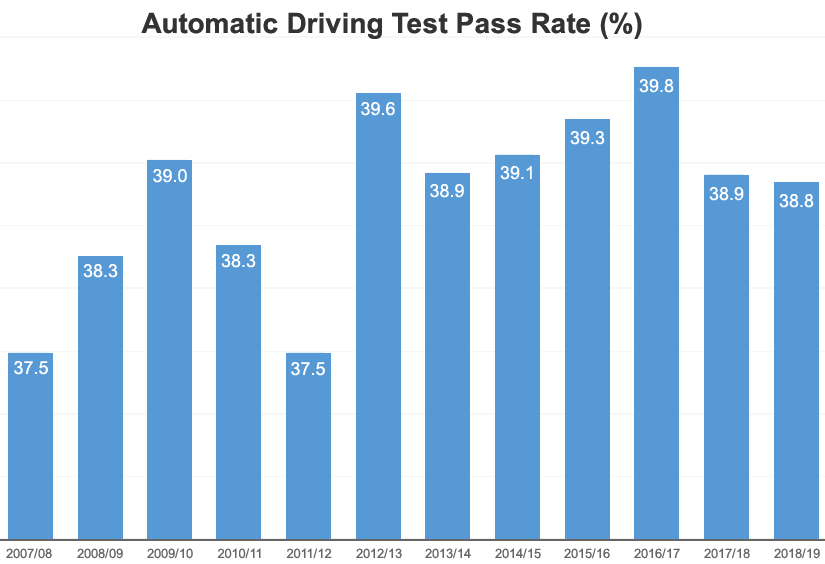Automatic Driving Test Pass Rates
Although many more leaner drivers are opting for the automatic driving test than ever before, for over a decade, the driving test pass rates for automatic cars has remained very similar. The following statistics are compiled from between August each year. The official DVSA automatic driving test pass rates are as follows:
| Year | Tests Conducted | Tests Passed | Pass Rate (%) |
|---|---|---|---|
| 2007/2008 | 70,429 | 26,400 | 37.5 |
| 2008/2009 | 75,716 | 28,964 | 38.3 |
| 2009/2010 | 71,454 | 27,884 | 39.0 |
| 2010/2011 | 83,554 | 32,036 | 38.3 |
| 2011/2012 | 70,429 | 26,400 | 37.5 |
| 2012/2013 | 87,844 | 34,749 | 39.6 |
| 2013/2014 | 95,759 | 37,266 | 38.9 |
| 2014/2015 | 105,948 | 41,391 | 39.1 |
| 2015/2016 | 114,994 | 45,238 | 39.3 |
| 2016/2017 | 141,264 | 56,172 | 39.8 |
| 2017/2018 | 163,790 | 63,727 | 38.9 |
| 2018/2019 | 185,043 | 71,870 | 38.8 |
| 2019/2020 | 202,506 | 24,996 | 39.4 |
Interestingly, based on the automatic driving test pass rates of August 2018 to August 2019 of 38.8 percent, over the same period, the pass rates for manual cars was 46.6 percent (1,479,126 total tests of which 690,102 passed). That’s almost an additional 8 percent of test candidates passing in a manual car compared to automatics.
Why are Automatic Test Pass Rates so Low?
Automatic cars are easier to drive. There’s no clutch or gears to worry about, so why the low pass rates? Essentially, there’s been no research into this, so it’s really down to opinion. There are however some likely factors that go some way into explaining this:
Location
Of all 1,664,219 driving tests taken between August 2018 to August 2019, 11.1 percent were automatic. The vast majority of candidates that take the test in automatic cars live in big cities. In fact, the majority of automatic tests are taken at London based test centres. Busy city test centres on average have much lower pass rates than other UK based test centres which could go some way into explaining the low automatic test pass rates.
Male Vs Female Pass Rates
If we look at male pass rates compared to female pass rates during August 2018 to August 2019, males tend to fair somewhat better. For all 1,664,219 manual and automatic tests combined, 46.8 percent of those were taken by male test candidates who obtained a pass rate of 49.6 percent. 53.2 percent were female with a 42.4 percent pass rate. That puts males at a 7.2 percent advantage.
Now if we look at automatic tests, of the 185,043 tests conducted, significantly more females opt for automatics at 75.1 percent. The pass rate for automatic tests being 37 percent for females and 44.2 percent for males.
Should I Still Consider Automatic?
The lower automatic test pass rates are based purely on circumstances; be it test centre location and the fact that female learner drivers have a slightly lower pass rate than males. Other factors may include learners that are driving a manual car, who are finding difficulties and decide to switch to automatic.
Some learners make the switch thinking automatic is going to make everything right, but fail to rectify the actual underlying reasons that are causing issues.
Realistically, there’s just as much chance of you passing a test in an automatic car as there is a manual. If you really do struggle with gear changing and clutch control, choosing an automatic car is simply going to help you reach test standard sooner.
Test Centres with the Highest and Lowest Pass Rates
Automatic driving test pass rates vary considerably throughout the UK depending on which test centre you take your test at. From an incredible 80% pass rate at once test centre to an almost impossible 23% at another, choosing your test centre can literally be the difference of passing or failing the driving test. Let’s take a look at which test centres have the highest and lowest automatic driving test pass rates.
Test Centres with Highest Automatic Pass Rates
Test Centres with Lowest Automatic Pass Rates
